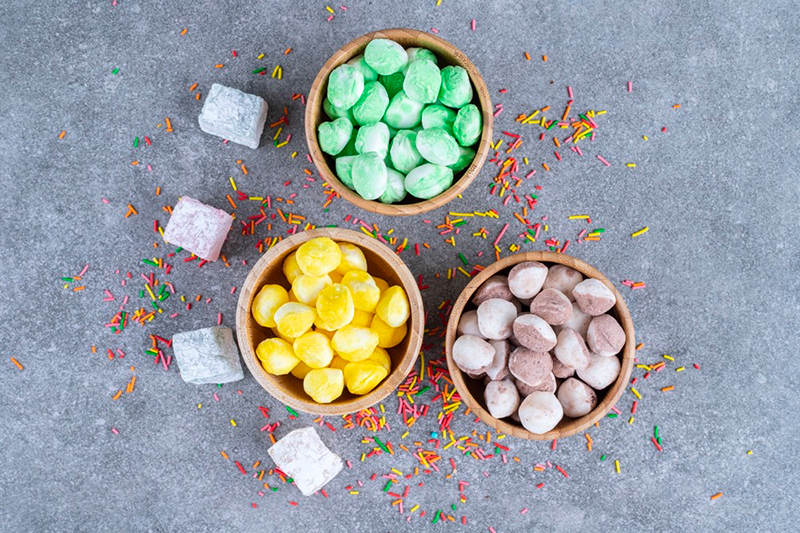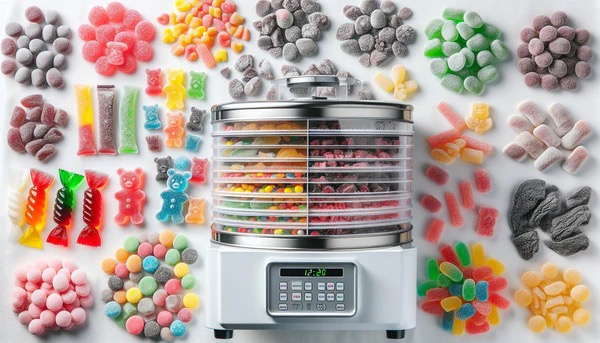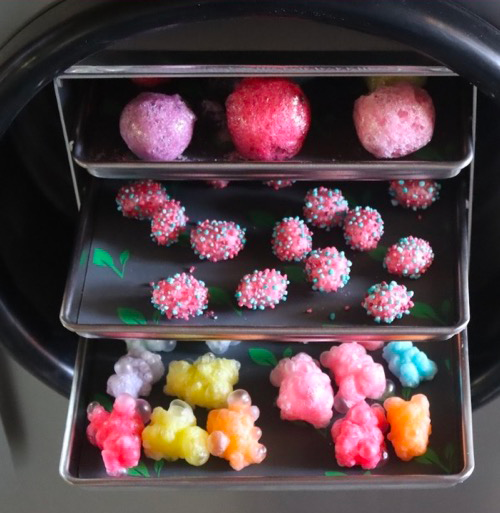
Content Menu
● What is Freeze-Dried Candy?
● Understanding the Processes: Dehydration vs. Freeze-Drying
● Can You Make Freeze-Dried Candy in a Dehydrator?
● How to Use a Food Dehydrator for Candy
>> Step 1: Choose Your Candy
>> Step 2: Prepare Your Dehydrator
>> Step 3: Set the Temperature
>> Step 4: Dehydrate
>> Step 5: Store Your Dried Candy
● Creative Uses for Dried Candy
● Health Benefits of Using a Food Dehydrator
● Tips for Effective Dehydrating
● Common Mistakes When Using a Food Dehydrator
● More About Food Dehydrators
>> Types of Food Dehydrators
● Benefits of Using Food Dehydrators
● Popular Foods Suitable for Dehydration
● Recipes Using Dried Ingredients
>> Dried Fruit Trail Mix
>> Vegetable Chips
>> Herb Seasoning Blend
● Maintaining Your Food Dehydrator
● Conclusion
● FAQs
>> 1. What types of candy work best in a dehydrator?
>> 2. Can I use chocolate in my dehydrator?
>> 3. How long does it take to dehydrate candy?
>> 4. Can I store dehydrated candy long-term?
>> 5. Is there any way to achieve freeze-dried texture at home?
● Citations:
The world of candy has seen a delightful twist with the rise of freeze-dried treats. The unique texture and intensified flavors of freeze-dried candy have piqued the interest of many home cooks and candy enthusiasts. But can you replicate this process using a food dehydrator? This article will explore the nuances of freeze-drying candy, the capabilities of food dehydrators, and provide a comprehensive guide on how to create your own treats.

What is Freeze-Dried Candy?
Freeze-dried candy refers to candies that have undergone a special process to remove moisture while preserving their shape, flavor, and nutritional value. This method results in a crunchy texture that is both light and airy, making them a popular choice for snacking.
Key Characteristics of Freeze-Dried Candy:
- Texture: Crunchy and light, differing significantly from traditional chewy or gummy candies.
- Flavor: The flavor becomes more concentrated due to the removal of moisture.
- Shelf Life: Freeze-dried candies have a longer shelf life compared to regular candies because they are devoid of moisture, which prevents spoilage.
Understanding the Processes: Dehydration vs. Freeze-Drying
While both dehydration and freeze-drying aim to remove moisture from food, they utilize different methods and yield different results.
| Aspect | Dehydration | Freeze-Drying |
| Process | Uses heat and airflow to evaporate moisture | Involves freezing the food and then reducing pressure to allow sublimation |
| Texture | Often results in a tougher texture | Creates a light, crispy texture |
| Flavor Preservation | May lose some flavor during the process | Retains most flavors due to gentle processing |
| Equipment Needed | Food dehydrator | Freeze dryer (or specialized equipment) |
Can You Make Freeze-Dried Candy in a Dehydrator?
The short answer is no; you cannot effectively make freeze-dried candy using a food dehydrator. While dehydrators can remove moisture, they do not create the same environment as freeze dryers.
- Temperature Control: Dehydrators operate at higher temperatures (typically 95°F to 160°F), which can alter the candy's structure and flavor.
- Vacuum Environment: Freeze dryers create a vacuum that allows ice to sublimate directly into vapor without passing through a liquid phase. This is crucial for maintaining the integrity of the candy.
How to Use a Food Dehydrator for Candy
While you cannot achieve true freeze-dried candy in a dehydrator, you can still create enjoyable dried candy snacks. Here's how:
Step 1: Choose Your Candy
Select candies that are suitable for dehydration. Ideal choices include:
- Gummy candies (like gummy bears)
- Marshmallows
- Hard candies (like Skittles)
Avoid high-fat or liquid-rich candies like chocolate or caramel, as they do not dehydrate well.
Step 2: Prepare Your Dehydrator
1. Line the trays with parchment paper to prevent sticking.
2. Arrange the candies in a single layer, ensuring they do not touch each other.
Step 3: Set the Temperature
Set your dehydrator to its lowest setting, ideally between 95°F and 110°F (35°C to 43°C).
Step 4: Dehydrate
Let the machine run for 24 to 48 hours, checking periodically for doneness. The candies should become dry and brittle when ready.
Step 5: Store Your Dried Candy
Once fully dehydrated, let them cool before transferring them into airtight containers to prevent moisture reabsorption.
Creative Uses for Dried Candy
Dried candy can be used in various ways:
- As toppings for desserts like ice cream or cakes
- Mixed into trail mixes
- Added to hot beverages like coffee or hot chocolate

Health Benefits of Using a Food Dehydrator
Using a food dehydrator offers several health benefits:
- Nutrient Preservation: Dehydrating food at low temperatures helps retain nutrients that might be lost during cooking methods like boiling or frying.
- Reduced Sugar Intake: By making your own dried snacks, you can control the amount of added sugar compared to store-bought versions.
- Increased Fiber Intake: Dried fruits and vegetables are high in fiber, which is essential for digestive health.
- Healthy Snacking Options: Dried fruits and vegetables can serve as nutritious snacks that are lower in calories than many processed snacks.
Tips for Effective Dehydrating
To maximize your results when using a food dehydrator, consider these tips:
- Cut Uniformly: Ensure all pieces are cut evenly so they dehydrate at the same rate. Use a mandoline slicer for consistent thickness.
- Avoid Overloading Trays: Spread out items on trays without overcrowding them; this allows better air circulation and more even drying.
- Rotate Trays Regularly: If your dehydrator doesn't have an automatic rotation feature, manually rotate trays every few hours for uniform drying.
- Check Moisture Levels: Before storing dried foods, ensure they are completely dry; any remaining moisture can lead to spoilage.
Common Mistakes When Using a Food Dehydrator
Even experienced users can make mistakes with their dehydrators. Here are some common pitfalls:
- Not Prepping Properly: Failing to wash and slice fruits or vegetables correctly can lead to uneven drying and poor texture.
- Ignoring Temperature Guidelines: Each type of food has an ideal drying temperature; not adhering to these guidelines can result in overcooked or undercooked items.
- Storing Improperly: Not using airtight containers or storing in humid environments can cause dried foods to lose their crispness or go bad quickly.
More About Food Dehydrators
Food dehydrators are versatile appliances designed specifically for removing moisture from various foods while preserving their nutrients. They work by circulating warm air around the food items placed inside them at low temperatures—typically between 85°F (29°C) and 160°F (71°C). This method helps prevent spoilage by inhibiting bacterial growth while retaining most of the food's original flavor and nutritional content[1][4].
Types of Food Dehydrators
When considering purchasing a food dehydrator, it's essential to understand that there are different types available on the market:
1. Stackable Tray Dehydrators: These models consist of several trays stacked on top of each other. They are generally more affordable but may require manual rotation of trays during use for even drying.
2. Shelf Dehydrators: These units have shelves that slide out like an oven rack. They often come with better airflow designs which promote even drying without needing tray rotation.
3. Hybrid Dehydrators: Some modern machines combine features such as convection heating with adjustable temperature settings tailored specifically for different types of foods[10].
Benefits of Using Food Dehydrators
Using a food dehydrator offers numerous advantages:
- Cost Savings: By preserving seasonal fruits or bulk purchases at lower prices through dehydration rather than letting them spoil[4].
- Control Over Ingredients: Making your own dried snacks allows you complete control over added sugars or preservatives often found in commercial products.
- Space Efficiency: Dried foods take up less space than fresh items when stored properly[7].
- Sustainability: Reducing waste by utilizing surplus produce helps contribute positively towards environmental sustainability efforts[6].
Popular Foods Suitable for Dehydration
Beyond candies, many other foods lend themselves well to dehydration:
- Fruits: Apples, bananas, strawberries, peaches—these are popular choices due to their natural sweetness.
- Vegetables: Carrots, bell peppers, tomatoes—these vegetables retain much of their nutritional value when dried.
- Herbs: Basil, thyme, oregano—dried herbs maintain their flavors well over time.
- Meats: Lean cuts work best; jerky-making is popular among outdoor enthusiasts[6][9].
Recipes Using Dried Ingredients
Here are some creative recipes utilizing dried ingredients:
Dried Fruit Trail Mix
Combine equal parts dried fruits like apricots and cranberries with nuts such as almonds or walnuts along with dark chocolate chips for an energy-packed snack mix!
Vegetable Chips
Slice sweet potatoes thinly; season lightly with olive oil and sea salt before placing them in your dehydrator until crispy—perfect as an alternative snack option!
Herb Seasoning Blend
Mix equal parts dried basil, oregano & thyme together; store this blend in an airtight container—ideal seasoning for pasta dishes!
Maintaining Your Food Dehydrator
Proper maintenance ensures longevity:
1. Clean trays after each use by soaking them in warm soapy water—avoid abrasive cleaners that could scratch surfaces.
2. Regularly check heating elements & fans; ensure nothing obstructs airflow within units during operation[9].
3. Store it away from humidity when not in use—this helps prevent mold growth inside compartments[10].
Conclusion
While true freeze-drying requires specialized equipment that most home cooks do not possess, using a food dehydrator can still yield enjoyable dried candy snacks. Understanding the differences between dehydration and freeze-drying is crucial for anyone looking to experiment with candy preservation methods.
In summary, if you're aiming for that crunchy texture and intense flavor associated with freeze-dried candy, investing in a freeze dryer may be worthwhile. However, if you're simply looking to enjoy dried versions of your favorite treats, your food dehydrator will serve you well.

FAQs
1. What types of candy work best in a dehydrator?
Gummy candies and marshmallows are ideal choices as they dehydrate well without losing their structure.
2. Can I use chocolate in my dehydrator?
No, chocolate does not dehydrate well due to its fat content; it tends to melt and become sticky rather than dry.
3. How long does it take to dehydrate candy?
Dehydrating candy typically takes between 24 to 48 hours depending on humidity levels and the type of candy used.
4. Can I store dehydrated candy long-term?
Yes! Store them in airtight containers in a cool, dry place for maximum freshness.
5. Is there any way to achieve freeze-dried texture at home?
For true freeze-dried texture, you would need access to a freeze dryer or consider alternative methods like using dry ice or vacuum sealing with freezing techniques.
Citations:
[1] https://www.webstaurantstore.com/guide/741/food-dehydrators-buying-guide.html
[2] https://homesteadingfamily.com/how-to-freeze-dry-candy/
[3] https://www.cnet.com/pictures/tips-for-using-your-new-dehydrator/
[4] https://www.bestbuy.com/discover-learn/10-reasons-to-buy-a-food-dehydrator/pcmcat1634332391134
[5] https://sweetytreatyco.com/blogs/news/how-to-make-freeze-dried-candy
[6] https://www.backpackingchef.com/dehydrating-food.html
[7] https://www.webmd.com/diet/dehydrating-food-good-for-you
[8] https://kanpaifoods.com/blogs/news/how-to-make-freeze-dried-candy-a-simple-guide-for-sweet-treat-lovers
[9] https://www.osbheatpump.com/news/how-to-use-a-food-dehydrator-10-useful-tips-for-beginners-and-advanced-users/
[10] https://www.goodhousekeeping.com/appliances/a31904157/what-is-a-dehydrator/











